Abstract
A multifactorial approach to the aetiology of oesophageal cancer was made on the basis of a case-control study in Saitama prefecture, Japan. The joint risks of two factors were calculated directly from joint distributions, following a dichotomous exposure model. Three models of factor combinations were taken into account: two risk enhancing factors, two risk reducing factors, and risk enhancing and reducing factors. We observed remarkable risk elevations in the first model, and the observed joint risks were in the neighbourhood of the multiplicative products of single acting risks of individual factors. The highest odds ratios of about 10 or more were found with combinations of salty foods, excessive intake of rice and alcohol abuse. The second and third models also followed a multiplicative modification of risk. The lowest odds ratios of less than 0.2 were observed in the second model, with combinations of fruits and raw vegetables, fruits and seaweed, and raw vegetables and meat. In the third model, the increased risk caused by an enhancing factor was reduced proportionately to the presence of a risk reducing factor. Finally the dose-response relations of two factors were observed and shown to be categorised into three typical patterns of risk modification, following a three exposure level model. These patterns could be explained by both the dose-response relations of individual factors and the multiplicative modification of risk.
Full text
PDF

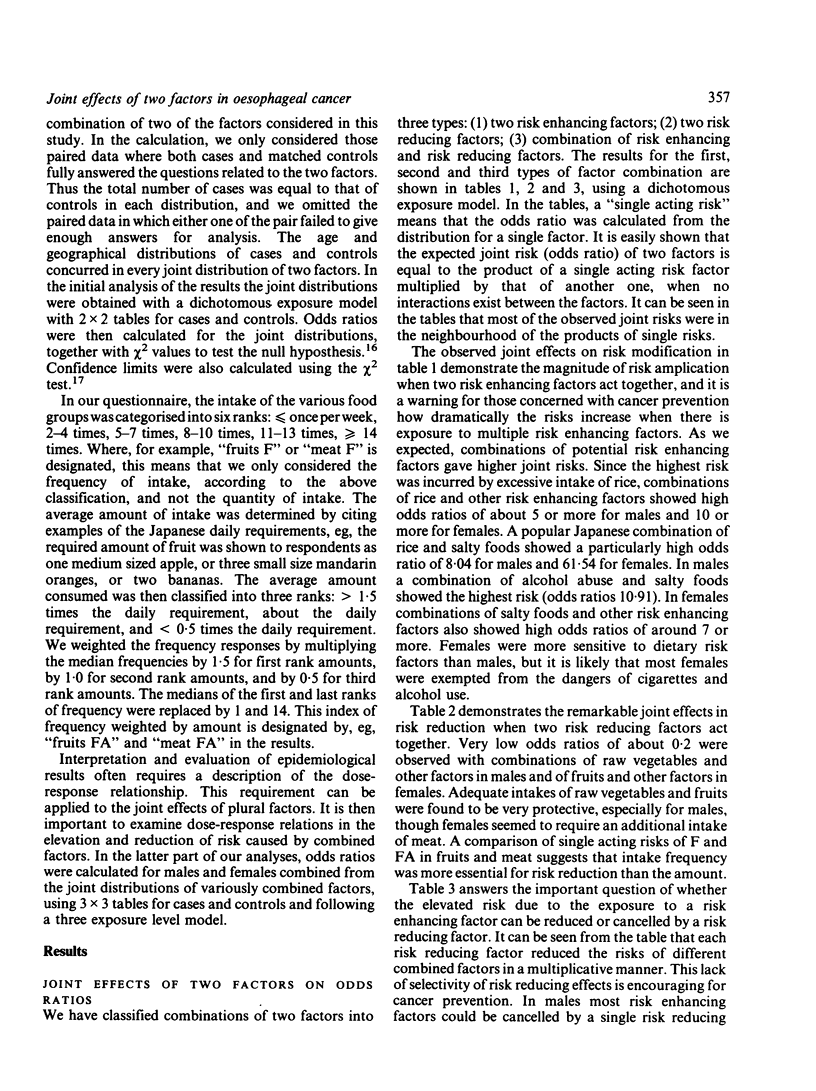
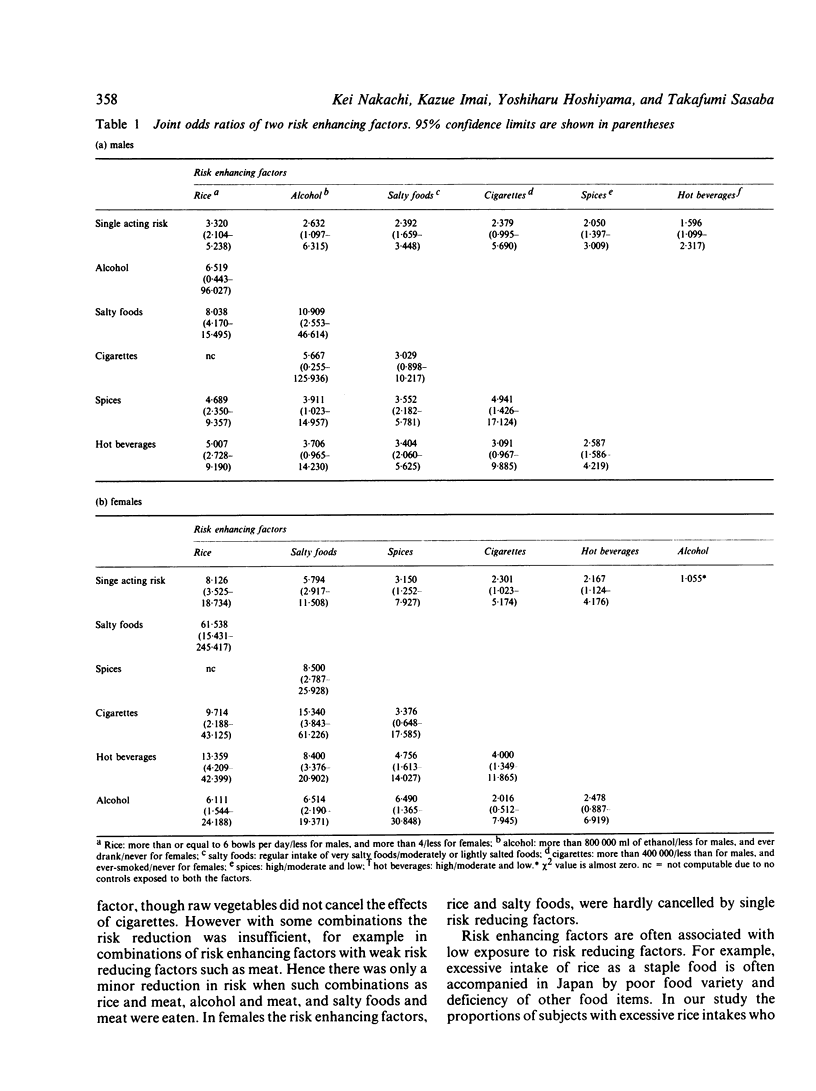

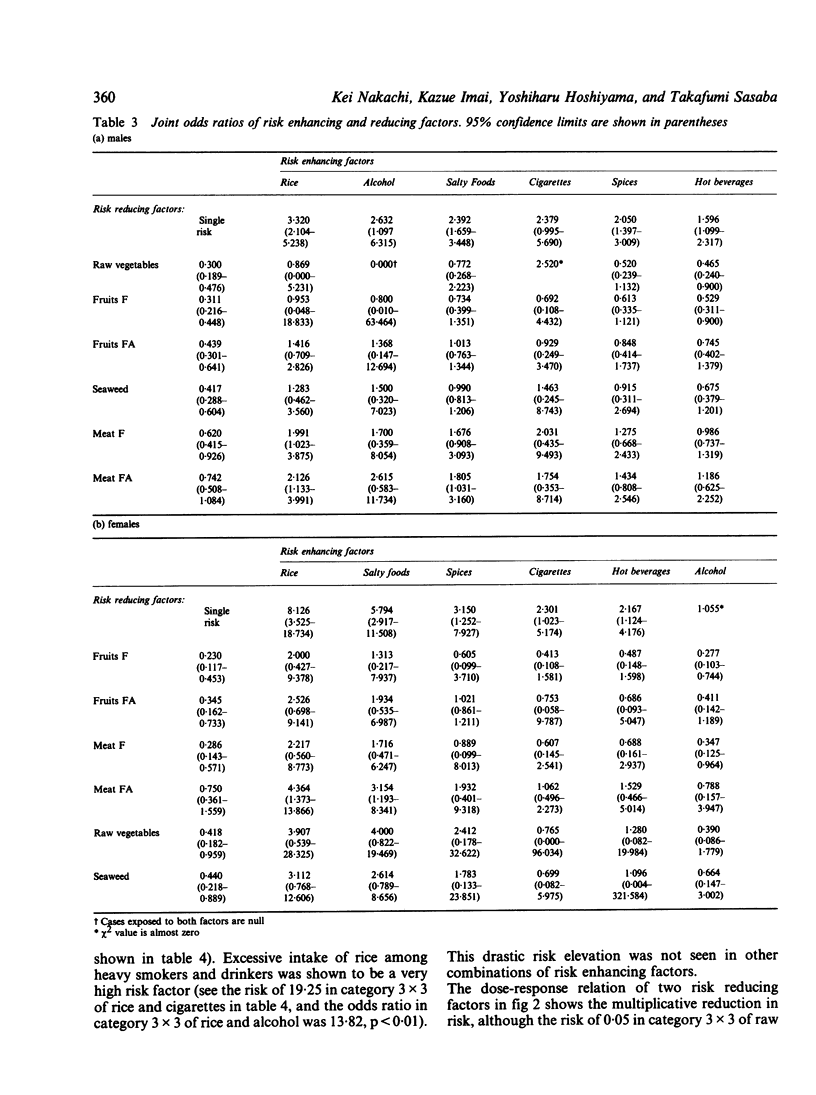
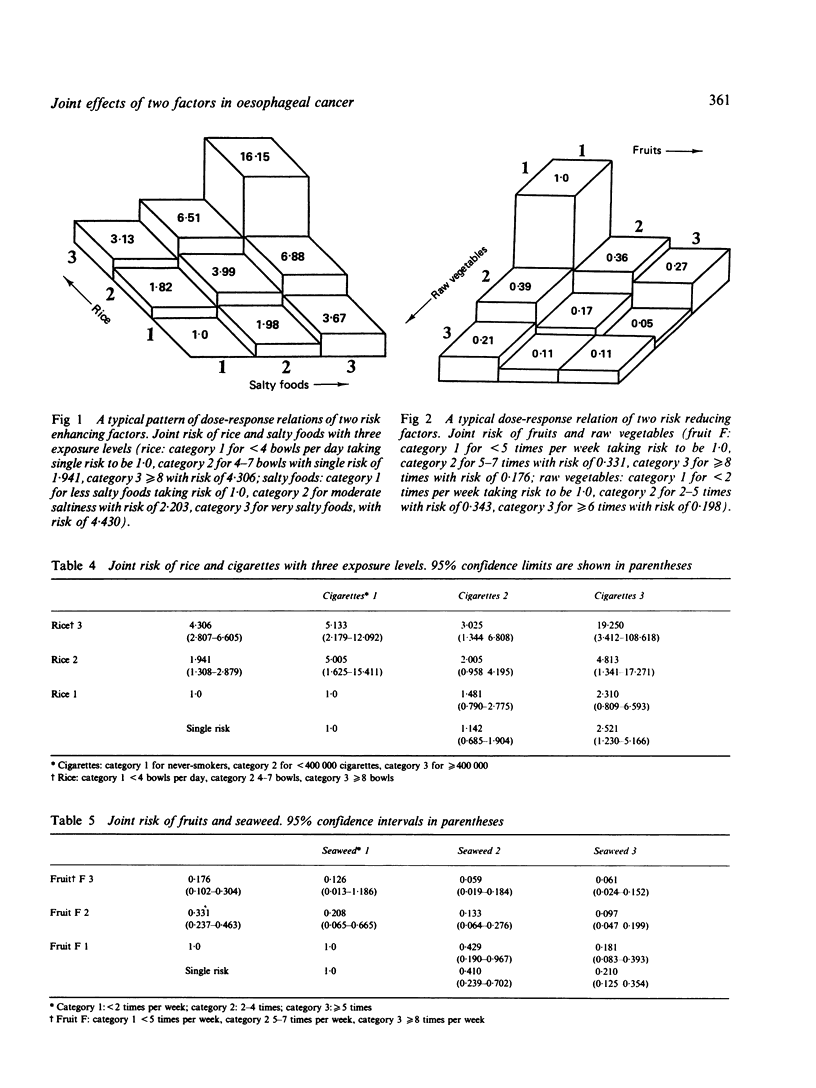
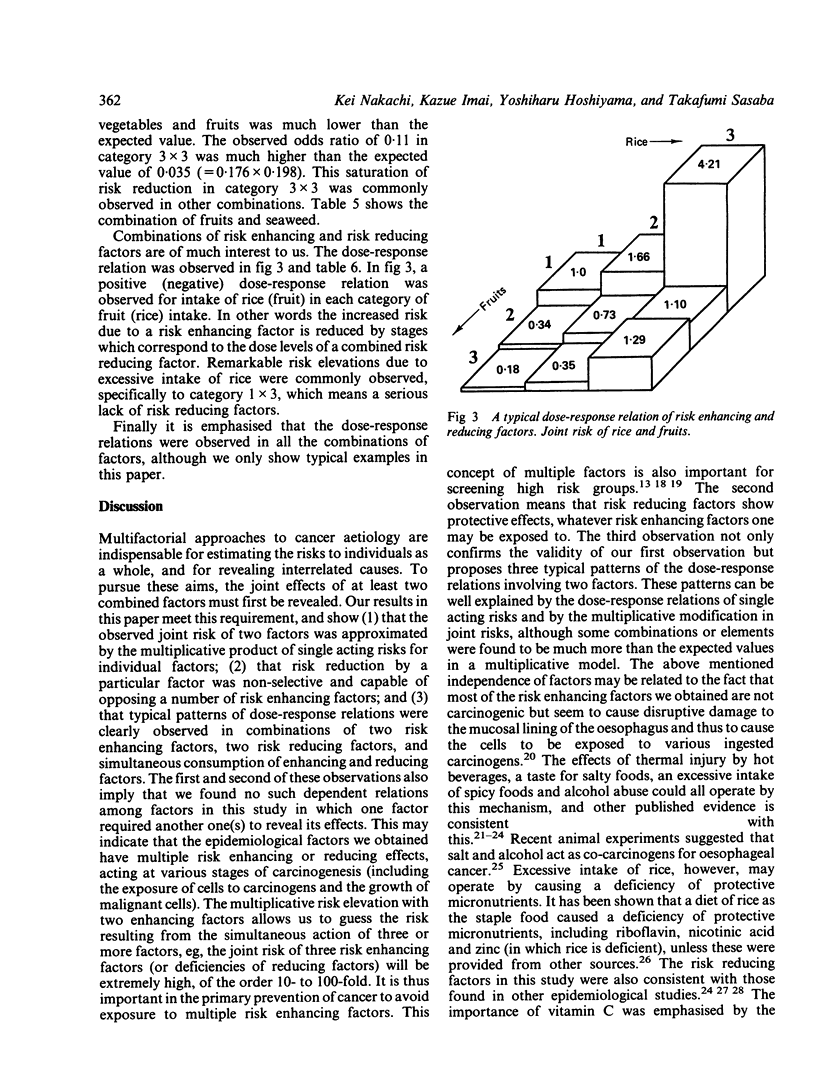
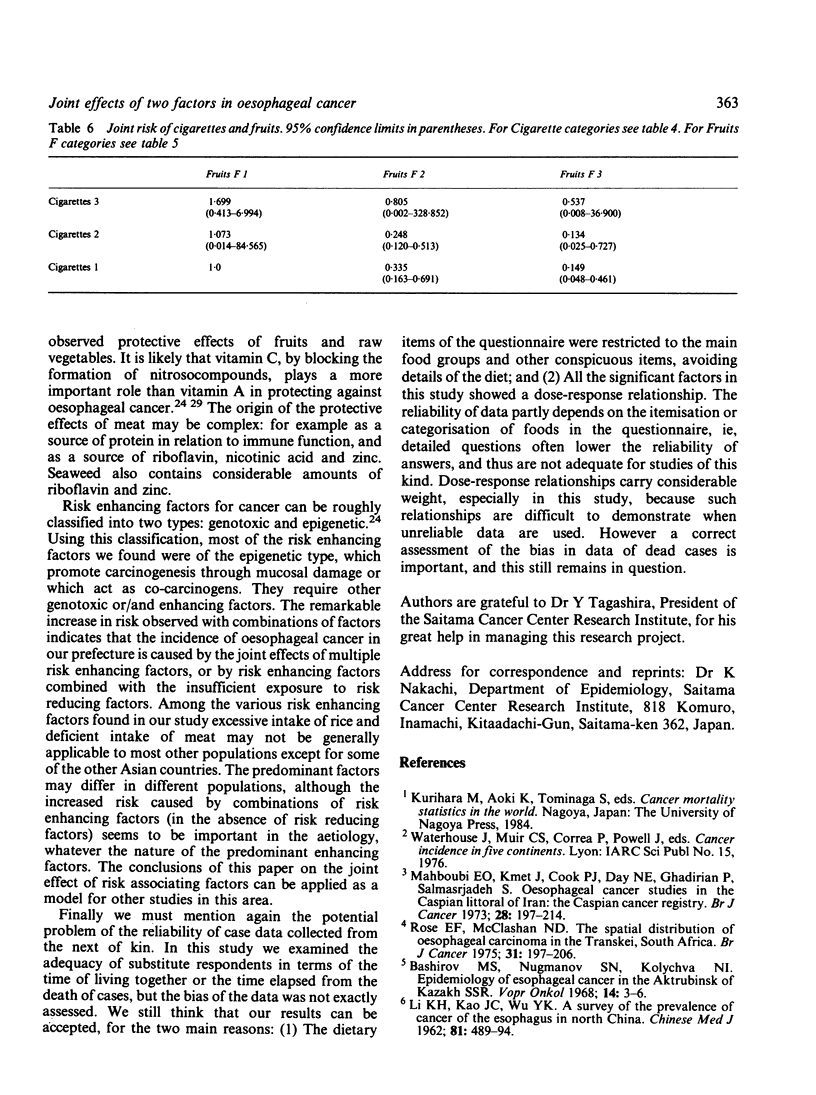
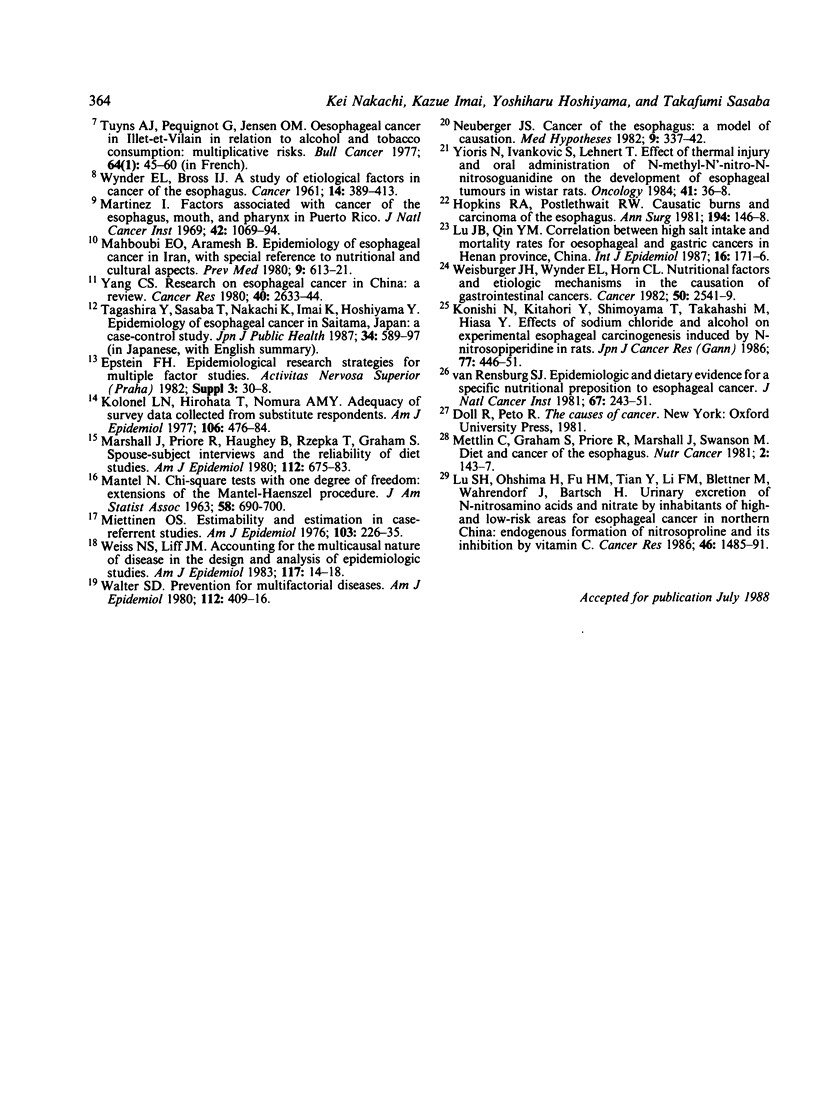
Selected References
These references are in PubMed. This may not be the complete list of references from this article.
- Bashirov M. Sh, Nugmanov S. N., Kolycheva N. I. K épidemiologii raka pishchevoda v Aktiubinskoi Oblasti Kazakhskoi SSR. Vopr Onkol. 1968;14(8):3–7. [PubMed] [Google Scholar]
- Hopkins R. A., Postlethwait R. W. Caustic burns and carcinoma of the esophagus. Ann Surg. 1981 Aug;194(2):146–148. doi: 10.1097/00000658-198108000-00005. [DOI] [PMC free article] [PubMed] [Google Scholar]
- Kolonel L. N., Hirohata T., Nomura A. M. Adequacy of survey data collected from substitute respondents. Am J Epidemiol. 1977 Dec;106(6):476–484. doi: 10.1093/oxfordjournals.aje.a112494. [DOI] [PubMed] [Google Scholar]
- Konishi N., Kitahori Y., Shimoyama T., Takahashi M., Hiasa Y. Effects of sodium chloride and alcohol on experimental esophageal carcinogenesis induced by N-nitrosopiperidine in rats. Jpn J Cancer Res. 1986 May;77(5):446–451. [PubMed] [Google Scholar]
- Lu J. B., Qin Y. M. Correlation between high salt intake and mortality rates for oesophageal and gastric cancers in Henan Province, China. Int J Epidemiol. 1987 Jun;16(2):171–176. doi: 10.1093/ije/16.2.171. [DOI] [PubMed] [Google Scholar]
- Lu S. H., Ohshima H., Fu H. M., Tian Y., Li F. M., Blettner M., Wahrendorf J., Bartsch H. Urinary excretion of N-nitrosamino acids and nitrate by inhabitants of high- and low-risk areas for esophageal cancer in Northern China: endogenous formation of nitrosoproline and its inhibition by vitamin C. Cancer Res. 1986 Mar;46(3):1485–1491. [PubMed] [Google Scholar]
- Mahboubi E. O., Aramesh B. Epidemiology of esophageal cancer in Iran, with special reference to nutritional and cultural aspects. Prev Med. 1980 Sep;9(5):613–621. doi: 10.1016/0091-7435(80)90033-x. [DOI] [PubMed] [Google Scholar]
- Mahboubi E., Kmet J., Cook P. J., Day N. E., Ghadirian P., Salmasizadeh S. Oesophageal cancer studies in the Caspian Littoral of Iran: the Caspian cancer registry. Br J Cancer. 1973 Sep;28(3):197–214. doi: 10.1038/bjc.1973.138. [DOI] [PMC free article] [PubMed] [Google Scholar]
- Marshall J., Priore R., Haughey B., Rzepka T., Graham S. Spouse-subject interviews and the reliability of diet studies. Am J Epidemiol. 1980 Nov;112(5):675–683. doi: 10.1093/oxfordjournals.aje.a113040. [DOI] [PubMed] [Google Scholar]
- Martinez I. Factors associated with ccer of the esophagus, mouth, and pharynx in Puerto Rico. J Natl Cancer Inst. 1969 Jun;42(6):1069–1094. [PubMed] [Google Scholar]
- Mettlin C., Graham S., Priore R., Marshall J., Swanson M. Diet and cancer of the esophagus. Nutr Cancer. 1981;2(3):143–147. doi: 10.1080/01635588109513674. [DOI] [PubMed] [Google Scholar]
- Miettinen O. Estimability and estimation in case-referent studies. Am J Epidemiol. 1976 Feb;103(2):226–235. doi: 10.1093/oxfordjournals.aje.a112220. [DOI] [PubMed] [Google Scholar]
- Neuberger J. S. Cancer of the esophagus: a model of causation. Med Hypotheses. 1982 Sep;9(3):337–342. doi: 10.1016/0306-9877(82)90164-5. [DOI] [PubMed] [Google Scholar]
- Rose E. F., McGlashan N. D. The spatial distribution of oesophageal carcinoma in the Transkei, South Africa. Br J Cancer. 1975 Feb;31(2):197–206. doi: 10.1038/bjc.1975.26. [DOI] [PMC free article] [PubMed] [Google Scholar]
- Tuyns A. J., Péquignot G., Jensen O. M. Le cancer de l'oesophage en Ille-et-Vilaine en fonction des niveaux de consommation d'alcool et de tabac. Des risques qui se multiplient. Bull Cancer. 1977;64(1):45–60. [PubMed] [Google Scholar]
- WYNDER E. L., BROSS I. J. A study of etiological factors in cancer of the esophagus. Cancer. 1961 Mar-Apr;14:389–413. doi: 10.1002/1097-0142(196103/04)14:2<389::aid-cncr2820140220>3.0.co;2-e. [DOI] [PubMed] [Google Scholar]
- Walter S. D. Prevention for multifactorial diseases. Am J Epidemiol. 1980 Sep;112(3):409–416. doi: 10.1093/oxfordjournals.aje.a113007. [DOI] [PubMed] [Google Scholar]
- Weisburger J. H., Wynder E. L., Horn C. L. Nutritional factors and etiologic mechanisms in the causation of gastrointestinal cancers. Cancer. 1982 Dec 1;50(11 Suppl):2541–2549. [PubMed] [Google Scholar]
- Weiss N. S., Liff J. M. Accounting for the multicausal nature of disease in the design and analysis of epidemiologic studies. Am J Epidemiol. 1983 Jan;117(1):14–18. doi: 10.1093/oxfordjournals.aje.a113509. [DOI] [PubMed] [Google Scholar]
- Yang C. S. Research on esophageal cancer in China: a review. Cancer Res. 1980 Aug;40(8 Pt 1):2633–2644. [PubMed] [Google Scholar]
- Yioris N., Ivankovic S., Lehnert T. Effect of thermal injury and oral administration of N-methyl-N'-Nitro-N-nitrosoguanidine on the development of esophageal tumors in Wistar rats. Oncology. 1984;41(1):36–38. doi: 10.1159/000225787. [DOI] [PubMed] [Google Scholar]
- van Rensburg S. J. Epidemiologic and dietary evidence for a specific nutritional predisposition to esophageal cancer. J Natl Cancer Inst. 1981 Aug;67(2):243–251. [PubMed] [Google Scholar]


